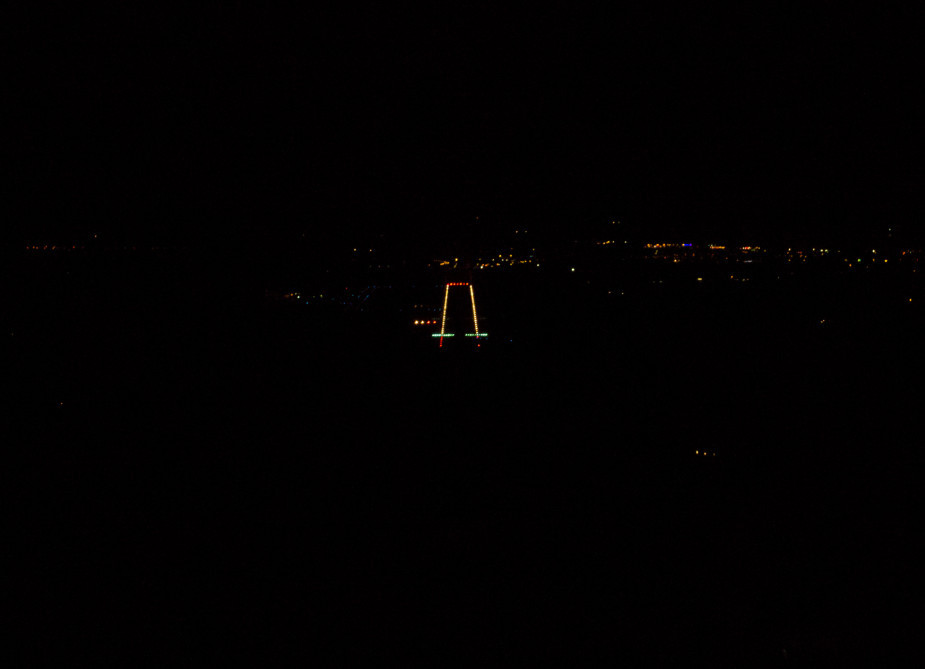Not sure how we get a scientific picture of CAT 1 at minimums in real life but this paragraph from the FAA is helpful, with emphasis added on my part.
As the runway threshold is approached, the visual glidepath separates into individual lights. At this point, the approach should be continued by reference to the runway touchdown zone markers. The approach lighting system (ALS) provides lights that will penetrate the atmosphere far enough from touchdown to give directional, distance, and glidepath information for safe visual transition.
Is the screenshot for a full ALS? Am with A_A, I would go around in real life if you hadn’t acquired the roll bars. Quite a few of the ILS fields in the UK do not have a full ALS, and accordingly have higher minima.
This video of an approach at MXP is quite informative, ceiling was around 400’ but it shows the lighting array at 200’ very clearly, with roll bars.
RobertL18C wrote:
This video of an approach at MXP is quite informative, ceiling was around 400’ but it shows the lighting array at 200’ very clearly, with roll bars.
Yes. But they have much more than 550m visibility. You can almost see the far end of the runway…
Of those various images, it is very much what_next’s that I have seen when making an approach in 550m. And that is a rather long set of lights.
Others may feel confident in flying visually with that picture, I definitively do not. So I look up, announce to myself that I can see the lights and decide to land, and then get my head back inside.
I would be interested to see what a sample of qualified IRs do on what_next’s sim if forced to land visually from that point. I would like to bet that 75% of them go unstable, mostly by going below the slope.
what_next wrote:
Yes. But they have much more than 550m visibility. You can almost see the far end of the runway…
You would do. Anyone who has bothered to read the books would have observed that approach lights at maximum intensity are to have a brightness level 1.5-2.0 times the maximum intensity of the runway edge lights. RVR is measured using RW edge lights or equivalent.
In simple terms, if the RVR is 550m, you should be able to see an approach light at a minimum of 710m range. Funny old thing, a basic approach light system is designed such that you can attain enough of a visual reference at minimum RVR with crossbars being spaced at 150m +/-22.5m. Anything less (ie a simple, single cross bar and centreline system) will have the bar located about 300m from the RW threshold and would lead to an increased minimum prescribed RVR of 750m. Soooo, the bottom line is if you look-up at DA you should see more than enough of the entire approach light system, runway threshold etc in order to continue visually. If you cannot confirm “visual references for the intended runway is distinctly visible and identifiable to the pilot”, in this case being “elements of the approach lighting system” (note plural) you go around. The key bit, probably interpreted by the more intrepid, is “distinctly visible”.
The elements of the ALS used to be defined as two horizontal bars and the vertical lights between. Has that changed? Where is it specified?
Most of my experience of 550m dates back to the 90s, but I have landed in it a few times in the last few years, and there is no question, in those visibilities, by day, of seeing any more than parts of the approach lights.
It is, of course, better at night, when many more lights show through the fog.
If the books say different, so be it. I wonder if the authors have been up to have a look for themselves.
Timothy wrote:
but I have landed in it a few times in the last few years
You’ve also ended-up off the far end of the runway in it.
Dave_Phillips wrote:
Soooo, the bottom line is if you look-up at DA you should see more than enough of the entire approach light system, runway threshold etc in order to continue visually. If you cannot confirm “visual references for the intended runway is distinctly visible and identifiable to the pilot”, in this case being “elements of the approach lighting system” (note plural) you go around. The key bit, probably interpreted by the more intrepid, is “distinctly visible”.
Which I think is consistent with W_Ns picture. While it is faint on a photo, you get the centreline lights and two crossbars.
The approach lights are indeed a lot brighter than the runway edge lights (EGMD, 2008)

(last time I posted that pic, someone kindly emailed me a photoshopped version of it showing 2 reds and 2 greens  )
)
but sometimes you don’t have them (LFBE, 2014)
